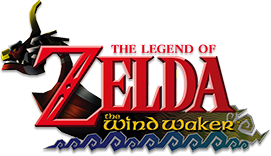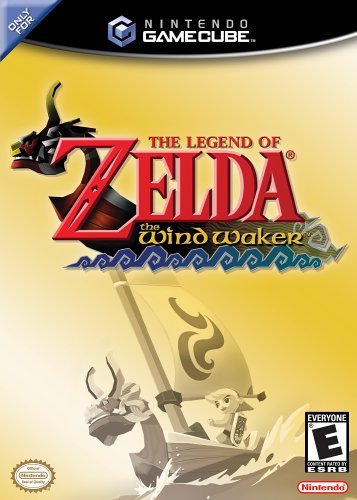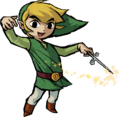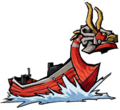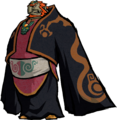The Legend of Zelda: The Wind Waker
| Release | ||
|---|---|---|
Platform | Date | |
| Credits | ||
Developer | ||
Producer | ||
Director | ||
| Guides | ||
Walkthrough | ||
| Media | ||
Gallery | ||
Music | ||

|
In-depth guide:
The Wind Waker Walkthrough |
The Legend of Zelda: The Wind Waker is the tenth installment in The Legend of Zelda series. It was also the first The Legend of Zelda title on the Nintendo GameCube.
On January 23rd, 2013, Eiji Aonuma announced a remake of The Wind Waker on the Nintendo Wii U, with updated HD graphics and a new interface.[2]
Story
- Main article: The Wind Waker Story
On the day of Link's birthday, his sister, Aryll, is captured by the Helmaroc King. Link joins a group of pirates led by Tetra in order to rescue Aryll from the Forsaken Fortress. However, he is captured upon reaching the top of the fortress and thrown out. After meeting a sentient boat known as the King of Red Lions, Link learns that in order to rescue his sister, he must ultimately face Ganondorf, the true master of the Forsaken Fortress. Using the Wind Waker, Link and the King of Red Lions travel all over the Great Sea in an attempt to locate the legendary Master Sword and find the lost kingdom of Hyrule, including the power of the Triforce.
Gameplay
The Wind Waker continues the 3D gameplay from Ocarina of Time and Majora's Mask, but improves upon it. The game features new sword abilities to combat, most notably the parry attack, which allows the player to strike an enemy of guard at a certain time. The game also features a much larger world than the titles on the N64, and has a seamless transition from sailing to being on an island. Unlike the N64 titles, which have very square dungeons, The Wind Waker's dungeons are more dynamic.
Development
The game was originally designed without cel-shading in mind; Eiji Aonuma suggested that the game should use cel-shading as a way to introduce new ideas to the series. The game was originally planned to include transparent water, but this was scrapped very early in development.
The earliest trailer for the game, shown in Spaceworld 2001, showed that the lighting and particle systems were already in place. However, the voice of Link from Majora's Mask was used as a placeholder, as the final voices for Link had not been recorded yet. The game's HUD was created in a style akin to that of the two N64 Zelda games before it. Link himself had clothing slightly different from his final clothing at this stage.
After the cold response to the Spaceworld 2001 trailer, Shigeru Miyamoto declared that no more trailers for the game would be shown until the game was well into the beta phase.[3] In 2002, Nintendo showed the next trailer for the game at E3 in Los Angeles. By this time, Dragon Roost Cavern was nearing finalization, and a playable demo of Outset Island was included for attendees to try. The enemy music shown in the trailer was different from the final music, however. Link still had his early clothing from the Spaceworld 2001 trailer.
Between 2002 and 2003, more preview images of the game were released. The name of the game was revealed in October 2002, and in December, the English translation was revealed.[3] Link's clothing, as well as the HUD, were finalized to their current versions. Several dungeons were scrapped to save time for a December release in Japan and a slightly modified American release in March 2003.
Reception
During Spaceworld 2000, Nintendo showed several tech demos for the then-unreleased GameCube showing off the power of the system. One of the demos consisted of Link and Ganondorf battling each other. Fans and industry reporters assumed that the next Zelda game would be in a realistic style. However, during Spaceworld 2001, Nintendo showed a trailer for the new Zelda game featuring a cel-shaded child Link, eliciting anger from fans, many of whom criticized the graphics as "childish".
Professional reviewers were more forgiving to the game; many were neutral to the style, and some saw the style as hearkening back to the graphics style of A Link to the Past.[4]
When The Wind Waker was released in 2003, it received almost universal critical acclaim, in part due to the cel-shaded graphics style. Critics also praised the new gameplay mechanic of sailing, as well as the musical score. However, there were also points of contention about the game; the Great Sea featured in the game almost seemed too big, and sailing took quite a long time to accomplish, making side-quests and the storyline itself quite a long task to accomplish. Some critics also expressed dislike with the depth of field and character proportions, particularly the design of Link. Despite the negatives, the game received a 40/40 from the notoriously strict Japanese gaming magazine Famitsu, making The Wind Waker the second Zelda game to receive a perfect score from Famitsu.
Remakes
The Legend of Zelda: The Wind Waker HD
- Main article: The Legend of Zelda: The Wind Waker HD
On January 23rd, 2013 during a Nintendo Direct Wii U Games presentation, Nintendo announced that The Wind Waker was to be remade for the Wii U console. The game includes upgraded graphics, a tuned up overall game experience, ability to play it off-screen on the Wii U GamePad, and Miiverse compatibility.[5] It was slated for a release in October 2013.[6]
It was released in North America on September 20, 2013. In addition to updated graphics, The Wind Waker HD includes the Swift Sail, an updated Triforce Shard quest, and a Hero Mode like the one in Skyward Sword. The Wind Waker HD's Hero Mode adds a certain level of difficulty to the game by doubling the amount of damage that Link takes from enemies and removing Recovery Hearts from the game. A few minor changes made to the game are the change to the Pictograph Box to allow it to hold 12 pictures at a time, the ability to take pictures of Link, and the addition of the Tingle Bottle, which replaced the Tingle Tuner.
Graphics
The Wind Waker uses a unique style of cel-shading, designed to emulate the style of a large-studio animated film instead of the simpler style of a comic book or television animation. As such, background elements use textures that are somewhat more detailed than those used for non-static objects, such as characters. Most lighting on background elements is pre-rendered, though the game also uses much real-time lighting on all objects. A cloth simulation system, which affects cloth, hair, grass, and particles, provides some realism, as does the subtle depth of field effect and image distortion caused by heat. The graphics style itself was partly influenced by Japanese feature animation.
Races
- Main article: The Wind Waker Races
Characters
Enemies
Items
Locations
The Wind Waker is set on the Great Sea. There are 49 islands in the Great Sea to explore along with enemy Submarines and Platforms. He travels the Great Sea with the help of a talking boat known as the King of Red Lions. Link can use the Wind Waker to control the flow of the winds, which allows him to set his course without dependence on the wild nature of the winds of the ocean. When Link arrives at an island for the first time, he can ask a Fishman for information on said island, as well as a map of the territory and its position on the Great Sea.
Music
The Wind Waker's music had an overall Irish theme, with wood winds and string instruments taking center stage in crafting a beautiful sound track for the world to fall in love with. The Overworld theme is replaced with “The Great Sea”. Link does not use an instrument in this game, instead using a conductor's baton, the Wind Waker. With this Link conducts tunes in ¾, 4/4, and even 6/4.
Other media
Merchandise
- The Wind Waker Sports Watch was a free GameStop giveaway in early 2003 with the purchase of a Nintendo GameCube, used to get customers in GameStop stores, and to push sales for the GameCube and The Wind Waker.
- The Wind Waker Bobblehead Doll was a free limited giveaway at Target retail stores.
- The Wind Waker Yujin Gashapon Figures are a 5 piece set of small figures of Link, Aryll, and Tetra. These were released exclusively in Japan at 200 Yen a piece.
Gallery
- Main article: Gallery:The Wind Waker
Screenshots
- Main article: Category:The Wind Waker (GCN) Screenshot Files
Videos
American Commerical
Japanese Commerical
Game Intro
E3 2002 presentation for The Wind Waker
References
- ↑ Ruliweb
- ↑ Nintendo Direct, January 23rd, 2013
- ↑ 3.1 3.2 Wikipedia: The Legend of Zelda: The Wind Waker
- ↑ "Celda: A Retrospective" - Super Train Station H
- ↑ Nintendo Direct, January 23rd, 2013
- ↑ [https://web.archive.org/web/20131206035842/http://e3.nintendo.com:80/games/detail/the-legend-of-zelda-wind-waker/ Nintendo E3 Web Site



